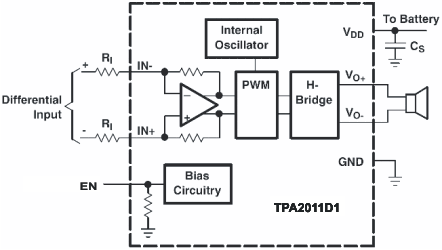SLOS626B December 2009 – November 2015 TPA2011D1
PRODUCTION DATA.
- 1 Features
- 2 Applications
- 3 Description
- 4 Revision History
- 5 Device Comparison Table
- 6 Pin Configuration and Functions
- 7 Specifications
- 8 Parameter Measurement Information
- 9 Detailed Description
- 10Application and Implementation
- 11Power Supply Recommendations
- 12Layout
- 13Device and Documentation Support
- 14Mechanical, Packaging, and Orderable Information
1 Features
- Powerful Mono Class-D Amplifier
- 3.24 W (4 Ω, 5 V, 10% THDN)
- 2.57 W (4 Ω, 5 V, 1% THDN)
- 1.80 W (8 Ω, 5 V, 10% THDN)
- 1.46 W (8 Ω, 5 V, 1% THDN)
- Integrated Feedback Resistor of 300 kΩ
- Integrated Image Reject Filter for DAC Noise Reduction
- Low Output Noise of 20 μV
- Low Quiescent Current of 1.5 mA
- Auto Recovering Short-Circuit Protection
- Thermal Overload Protection
- 9-Ball, 1.21mm x 1.16 mm 0.4 mm Pitch DSBGA
2 Applications
- Wireless or Cellular Handsets and PDAs
- Portable Navigation Devices
- General Portable Audio Devices
3 Description
The TPA2011D1 is a 3.2-W high efficiency filter-free class-D audio power amplifier (class-D amp) in a 1.21 mm × 1.16 mm wafer chip scale package (DSBGA) that requires only three external components.
Features like 95% efficiency, 86-dB PSRR, 1.5 mA quiescent current and improved RF immunity make the TPA2011D1 class-D amp ideal for cellular handsets. A fast start-up time of 4 ms with no audible turn-on pop makes the TPA2011D1 ideal for PDA and smart-phone applications. The TPA2011D1 allows independent gain while summing signals from separate sources, and has a low 20 μV noise floor.
Device Information(1)
| PART NUMBER | PACKAGE | BODY SIZE (NOM) |
|---|---|---|
| TPA2011D1 | DSBGA (9) | 1.60 mm x 1.21 mm |
- For all available packages, see the orderable addendum at the end of the data sheet.
Typical Application Diagram
